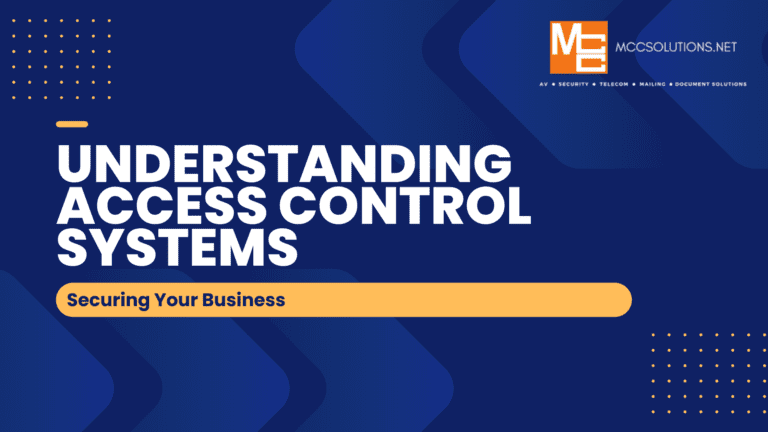Our Blog

Understanding Access Control Systems
Securing Your Business
In today’s business environment, where the security of office spaces is paramount for the protection of employees and sensitive information, the role of access control systems cannot be overstated. Failing to maintain robust security measures can lead to catastrophic breaches, which could damage a company’s reputation and put staff at risk. According to a survey by Security Magazine, 43% of businesses reported experiencing unauthorized access incidents in the past year. Access control systems, with their ability to manage who enters and exits your premises, provide a reliable solution for ensuring a safer workplace and safeguarding valuable assets.
What are Access Control Systems?
Access control systems, which are electronic systems designed to control who can enter and exit specific areas within a facility, come in various forms. These range from simple fob swipe systems, where a keycard is used for entry, to advanced biometric recognition setups, which use unique physical characteristics like fingerprints for verification. The core function of these systems is to verify the identity of individuals and grant access accordingly. In addition to enhancing security, access control systems offer several supplementary benefits, such as monitoring attendance for payroll purposes and tracking building occupancy in real-time.
Benefits of Access Control Systems
- Enhanced Security: By restricting access to authorized personnel only, access control systems help prevent unauthorized entry, thereby reducing the risk of theft, vandalism, and violence.
- Employee Safety: Monitoring and controlling who enters the building ensures that only trustworthy individuals are present, contributing to a safer work environment.
- Operational Efficiency: These systems streamline attendance tracking and facilitate efficient timekeeping, aiding payroll management.
- Data Protection: Secure access to areas containing sensitive documents and data helps protect against information breaches and leaks.


What are the Potential Costs Associated with Implenting an Access Control System?
The potential costs associated with implementing different types of access control systems can vary based on several factors, including the size of the facility, the level of security required, and the specific features of the system. Here are some key considerations when evaluating the potential costs:
1. System Hardware and Installation: The initial cost of access control systems can involve the purchase of hardware such as card readers, biometric scanners, electronic locks, and control panels. Additionally, professional installation may be required, especially for more complex systems, which can add to the initial investment.
2. System Scalability: Consider the scalability of the access control system. Will it be easy to expand the system as your business grows or as security needs change? A scalable system may involve higher initial costs but can offer long-term flexibility and cost-effectiveness.
3. Ongoing Maintenance and Support: Budget for ongoing maintenance and support costs, including regular system updates, repairs, and technical support. Some systems may also require subscription fees for access to certain features or cloud-based services.
4. Integration with Existing Infrastructure: If integrating the access control system with other security or building management systems, consider the potential costs associated with compatibility, software integration, and any required modifications to existing infrastructure.
5. Training and User Support: Factor in the costs associated with training staff on how to use the system effectively and providing ongoing user support to address any issues or questions that may arise.
It’s important to conduct a thorough cost-benefit analysis of different access control systems to ensure that the chosen system aligns with both your security needs and your budget constraints. Additionally, consulting with security system providers and seeking multiple quotes can provide a clearer understanding of the potential costs associated with implementing and maintaining different types of access control systems.


What are the Best Practices for Implementing an Access Control System?
When it comes to selecting an access control system, it’s crucial to evaluate your specific security needs. The complexity of these systems varies, from basic keycard entry to multi-factor authentication involving biometric data. By understanding your security requirements and the available options, you can make an informed decision that meets your needs without incurring unnecessary costs for features you don’t need, empowering you to take control of your business’s security.
Types of Authentication
- Single-Factor Authentication: Involves one security element, such as a keycard or password.
- Two-Factor Authentication: Combines two elements, like a keycard and a PIN.
- Three-Factor Authentication: Uses three elements, such as a keycard, PIN, and biometric data (e.g., fingerprints).
- Multi-Man Authentication: Requires multiple individuals to be present to gain access, adding an extra layer of security.
The Layered Security Approach
A layered security strategy involves implementing multiple barriers to deter unauthorized access. Think of it like securing your home: adding a fence, locking doors, and installing an alarm system create several layers an intruder must bypass. Similarly, in a business setting, combining various access control methods enhances overall security and delays potential breaches, giving additional time for intervention.
Example of Layered Security
- Basic Layer: Entry requires a keycard swipe.
- Intermediate Layer: Additional PIN entry after keycard swipe.
- Advanced Layer: Biometric verification following PIN entry.
- Ultimate Layer: Multi-man authentication where two individuals must be present to access sensitive areas.
Are Their Regulatory or Compliance Requirements to Consider when Implementing Access Control?
When implementing an access control system, it is crucial to consider regulatory and compliance requirements that may be relevant to your organization. Depending on the industry and location, there may be specific regulations and standards that dictate how access control should be implemented. For instance, industries such as healthcare, finance, and government are often subject to strict regulations regarding data privacy and security.
Before finalizing an access control system, it is essential to conduct a thorough review of relevant regulations such as the Health Insurance Portability and Accountability Act (HIPAA), General Data Protection Regulation (GDPR), or Payment Card Industry Data Security Standard (PCI DSS). Additionally, local building codes and fire safety regulations may also have implications for access control systems, especially in emergency situations.
By carefully considering regulatory and compliance requirements upfront, organizations can ensure that their access control systems not only enhance security but also adhere to the necessary legal standards. This proactive approach can help prevent potential compliance issues and ensure that the access control system aligns with industry-specific regulations.
Potential Vulnerabilities of Access Control Systems and How to Mitigate Them
Access control systems, like any technology, are vulnerable to various risks that could compromise their effectiveness. Some potential vulnerabilities include system hacking, unauthorized duplication of access credentials, and physical tampering with the system components.
Mitigating these vulnerabilities requires implementing comprehensive security measures. To prevent system hacking, regular software updates and patches should be applied to address any identified vulnerabilities. Additionally, using strong encryption methods for data transmission and storage can bolster the system’s resistance to hacking attempts.

To mitigate the risk of unauthorized credential duplication, organizations should implement multi-factor authentication methods, such as biometric scans in addition to keycards or PIN codes. Regular audits of access credentials and prompt revocation of credentials for former employees are also crucial in minimizing this risk.
Physical tampering can be countered by installing access control system components in secure and monitored locations. Additionally, utilizing tamper-evident seals and alarm systems can provide an added layer of protection against unauthorized manipulation of the system.
By proactively addressing these potential vulnerabilities, organizations can ensure the robustness and reliability of their access control systems.
Conclusion
Investing in an access control system is a proactive step towards ensuring the safety and security of your business operations. By carefully selecting a system that meets your specific needs and implementing a layered security approach, you can significantly reduce the risk of unauthorized access and enhance overall workplace safety.
To learn more about the importance of physical security, read our post “Why Physical Security is Crucial to Business Success” or check out “5 Key considerations for Commercial Security Systems”
Schedule Your Free Security Audit Today
To find out how MCC's access control solutions can benefit your organization, contact us today and take the first step towards a more secure future.
Don’t forget to share!


